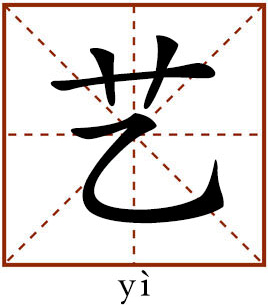Art

The original version of this character resembled a person holding a plant in hands. Since horticulture is viewed as a craft, this character gradually developed into meaning a craft or skill. Nowadays, it usually refers to art.
六艺
liù yì
Liu Yi, or the Six Arts, refers to the six skills that upper-class students were required to master in ancient China. It originated during the Zhou Dynasty (1046–256 BCE), and formed the basis of noble education in ancient Chinese culture. These six practical disciplines included rites, music, archery, chariot racing, calligraphy and arithmetic. Men who excelled in these six arts were thought to be gentlemen and more perfect members of society.
The Zhou Dynasty was the first dynasty to lay down rules of "rites" and "music." The rites include those practiced at sacrificial ceremonies and other ritual activities. Confucius described rites as traditional practices that provided a standard of conduct. Music originally refers to music and dancing which accompanied ceremony. In Confucianism, music is regarded as a device for self-cultivation, a vehicle for self-expression, a force for social stability, and a medium of communion between man, nature, and supernatural powers. According to The Analects, Confucius once said, "It is by the Odes that the mind is aroused. It is by the Rules of Propriety that the character is established. It is from Music that the finish is received" (trans. James Legge).
In ancient China, archery was an important aspect of life. Skill in archery was considered a virtue for Chinese nobles. Chariot racing was a popular sport in many ancient civilizations. In the Six Arts, it requires the charioteer to be excellent in all chariot racing skills from performance to chariot warfare. Writing, or calligraphy, and arithmetic represented the literary and academic accomplishments of a person.
The Six Arts have their roots in Confucian philosophy. They embody the Confucian values of ritual, self-discipline and social etiquette. It didn’t only represent the noble attributes which were highly valued in the ancient times, but are also considered valuable in the modern world.
Edited by REN GUANHONG
